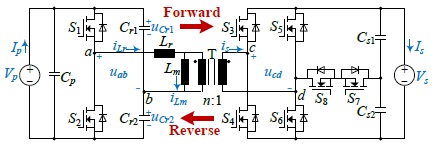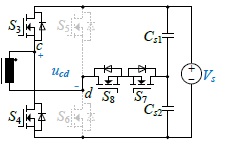- ALL COMPUTER, ELECTRONICS AND MECHANICAL COURSES AVAILABLE…. PROJECT GUIDANCE SINCE 2004. FOR FURTHER DETAILS CALL 9443117328


Projects > ELECTRICAL > 2017 > IEEE > POWER ELECTRONICS
This paper proposes a new bidirectional resonant dc-dc converter suitable for wide voltage gain range applications (e.g., energy storage systems). The proposed converter overcomes the narrow voltage gain range of conventional resonant DC-DC converters, and meanwhile achieves high efficiency throughout the wide range of operation voltage. It is achieved by configuring a full-bridge mode and a half-bridge mode operation during each switching cycle. A fixed-frequency phase-shift control scheme is proposed and the normalized voltage gain can be always from 0.5 to 1, regardless of the load. The transformer root-mean-square (RMS) currents in both the forward and reverse power flow directions have a small variation with respect to the voltage gain, which is beneficial to the conduction losses reduction throughout a wide voltage range. Moreover, the power devices are soft-switched for minimum switching losses. The operation principles and characteristics of the proposed converter are firstly analyzed in this paper. Then the analytical solutions for the voltage gain, soft-switching and RMS currents are derived, which facilitates the parameters design and optimization.
Optimization.
In this paper, a new bidirectional resonant dc-dc converter with fixed-frequency phase-shift control is proposed and explored. The operation principles and key characteristics, i.e., the voltage gain, power flow, soft-switching and RMS currents, are detailed. This paper proposes a new bidirectional resonant dc-dc converter which can achieve high efficiency over a wide voltage gain range. Instead of the conventional variable-frequency modulation, a fixed-frequency phase-shift modulation is proposed, and thus both the half-bridge mode and the full-bridge mode occur on the secondary side over each switching cycle. By adjusting the duration of half-bridge mode, a wide normalized gain range from 0.5 to 1 can be achieved in both power transfer directions regardless of the load. Instead of the widely used first harmonic approximation (FHA) method, the time-domain analysis is conducted in this research; as results, the analytical models for the voltage gain, power transfer, soft-switching, and RMS currents are derived and verified with simulations and experimental results. It is found that the inductors ratio has no impact on the voltage gain range; thus, on the premise of achieving ZVS, the magnetizing inductance can be designed possibly large to reduce conduction losses. Furthermore, the variation of conduction losses with respect to the voltage gain is small. As a result, high efficiency can be achieved over a wide gain range.
Schematic of the proposed bidirectional resonant dc-dc converter

Full-Bridge Mode
Half-bridge mode on the secondary side
